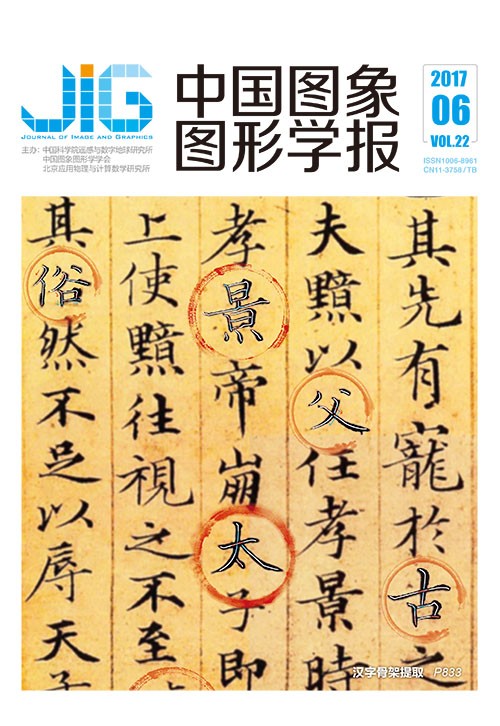
梯度分层重构的彩色图像分水岭分割
摘 要
目的 现实生活中的彩色图像往往因噪声、色彩不均匀、有较多弱边界等问题的存在导致难以准确分割,结合分水岭变换与形态学重构的优势,提出了一种基于同态滤波与形态学分层重构的分水岭分割算法。方法 首先提取彩色图像的梯度图,接着对该梯度图采用同态滤波修正梯度图。然后利用形态学开闭重构的方法,对滤波后的梯度图进行分层重构。根据梯度图像的累积分布函数及滤波后的梯度像素直方图的分布信息,给出了梯度分层数的计算公式,同时确定了形态学结构元素尺寸。最后对修正后的梯度图像应用标准分水岭变换实现了图像分割。结果 对不同类型的4幅彩色图像进行分割实验,采用区域一致性与差异性相结合的综合指标对分割结果进行无监督评价。这4幅图像的综合评价指标分别为0.6333、0.6656、0.6293、0.6484,均高于文献中两种现有分水岭算法的指标值:0.6295、0.6641、0.6230、0.6454与0.5861、0.5907、0.5704、0.5852,分割性能较好。结论 提出一种新的彩色图像分割算法,应用同态滤波保留了图像的弱边界,采用自适应形态学重构,抑制了分水岭变换中过分割。算法的分割结果更加接近人眼对图像的感知,无论从评价指标还是分割性能看,均表现出色。算法对噪声不敏感,鲁棒性较好,可广泛应用于计算机视觉、交通控制、生物医学等方面的目标分割。
关键词
Watershed algorithm based on gradient hierarchical reconstructions of color images
Wang Ya, Zhou Hailin, Ye Jianbing, Tan Shenyang(Department of Basic Science, Taizhou College of Nanjing University of Science and Technology, Taizhou 225300, China) Abstract
Objective Color image segmentation is an important image analysis technology, that has important applications in image recognition systems. The quality of image segmentation directly affects image processing. However, color images in real life are difficult to segment precisely because of noise, uneven color, and weak boundaries. This study proposed a watershed segmentation algorithm based on homomorphic filtering and morphological hierarchical reconstructions. By combining the advantages of homomorphic filtering, morphological operations, and watershed transform, the qualities of color image segmentations are improved.Method The watershed transform algorithm is widely used in image segmentation, because of its low computational burden, high accuracy, and continuous extraction. However, due to irregular regions and noises in an image, image segmentation relying solely on a watershed transform algorithm easily results in a large number of false contours. To improve the quality of image segmentation by watershed transform, this study adopted homomorphic filtering and morphological reconstruction. First, the proposed algorithm used the Sobel edge operator to compute the gradient of each color component according to the image's R, G, and B values. The maximum value was selected as the gradient of the color image. After extracting the gradient map of a color image, it was modified through homomorphic filtering using Fourier transform. Filtering highlights the foreground contour information and removes the detail texture noise. Irregular details and a small amount of noise still existed in the gradient image, especially in the boundary and background, after filtering, but the morphological reconstruction operators addressed this shortcoming. A modified gradient map was then reconstructed hierarchically by using the operators of open and close morphological reconstructions. According to the cumulative distribution function of the gradient map and the distribution information of the gradient histogram after filtering, the formula to calculate the number of gradient layers was provided, and the sizes of morphological structure elements, which decreased with the increase in the gradient value in each layer, were calculated adaptively. Finally, standard watershed transform was applied to the reconstructed gradient map, and image segmentation was realized.Result To verify the effectiveness of the algorithm, an experiment was conducted. Four color images of different features were utilized for segmentation in the experiment. The proposed algorithm effectively restrained over segmentation and maintained the weak boundary, so the segmentations were more accurate than those of other watershed algorithms. To objectively evaluate the performance of the different segmentation methods, the experimental results were quantified through an unsupervised evaluation of segmentations. The synthesize index combined with regional consistency and diversity indexes was applied. The evaluation index values of our algorithm in the four test images were 0.633 3, 0.665 6, 0.629 3, and 0.648 4, which were higher than the results of other watershed algorithms; the segmentation performance of our algorithm was also better. With regard to timeliness, our algorithm requires more time than the other two algorithms, but the difference was small.Conclusion Watershed transform is a widely used algorithm for image segmentation, but it often leads to over segmentation. Many methods focus on solving this problem while ignoring the weak boundaries of images, which are also important in segmentation. This study proposed a new improved watershed algorithm for color images. In the algorithm, homomorphic filtering is used to preserve the weak boundary of an image, and adaptive morphological reconstruction is applied to suppress the over segmentation of watershed transform. Balance exists between under and over segmentations. The segmentation results of the proposed algorithm are closer to the human perception of mages. Whether in terms of the evaluation index or segmentation performance, the proposed algorithm performs well. The algorithm is insensitive to noise, possesses good robustness, and can be widely application in computer vision, traffic control, biomedicine, and other targeted segmentations.
Keywords
homomorphic filtering morphological reconstruction watershed algorithm segmentation performance evaluation color image segmentation
|



 中国图象图形学报 │ 京ICP备05080539号-4 │ 本系统由
中国图象图形学报 │ 京ICP备05080539号-4 │ 本系统由